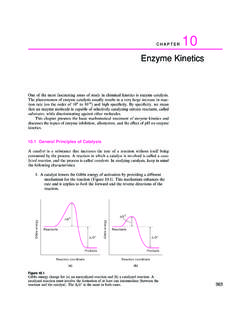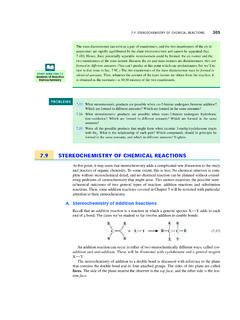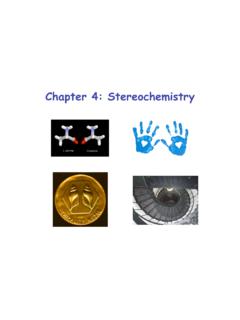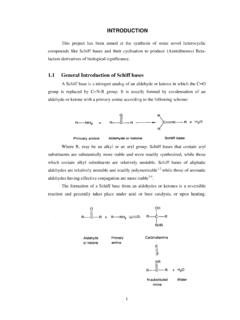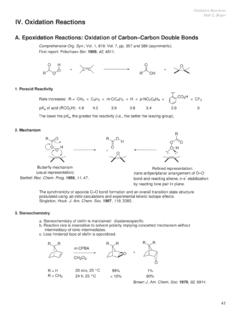Transcription of ModernPhysicalOrganicChemistry - University …
1 Modern Physical Organic , ,CaliforniaUniversity Science Manager:ChristineTaylorManuscript Editor:JohnMurdzekDesign:RobertIshiIllus trator:LineworksCompositor:Wilsted&Taylo rPublishingServicesPrinter & Binder:EdwardsBrothers, book is printed on acid-free 2005 by University Science BooksReproduction or translation of any part of this work beyond that permitted bySection 107 or 108 of the 1976 United States Copyright Act without the permissionof the copyright owner is unlawful. Requests for permission or further informationshould be addressed to the Permissions Department, University Science of Congress Cataloging-in-Publication DataAnsyln, Eric V., 1960 Modern physical organic chemistry / Eric V.
2 Anslyn, Dennis A. bibliographical references and 1 891389 31 9 (alk. paper)1. Chemistry, Physical organic. I. Dougherty, Dennis A., 1952 II. 2004547 .13 dc222004049617 Printed in the United States of America090807060510987654321vAbbreviated ContentspartI: Molecular Structure and Thermodynamicschapter1. Introduction to Structure and Models of Bonding 32. Strain and Stability 653. Solutions and Non-Covalent Binding Forces 1454. Molecular Recognition and Supramolecular Chemistry 2075. Acid Base Chemistry 2596. Stereochemistry 297partII: Reactivity, Kinetics, and Mechanismschapter7. Energy Surfaces and Kinetic Analyses 3558. Experiments Related to Thermodynamics and Kinetics 4219.
3 Catalysis 48910. Organic Reaction Mechanisms, Part 1:Reactions Involving Additions and/or Eliminations Reaction Mechanisms, Part 2:Substitutions at Aliphatic Centers and ThermalIsomerizations/Rearrangements 62712. Organotransition Metal Reaction Mechanisms and Catalysis 705 Intent and Purpose 70513. Organic Polymer and Materials Chemistry 753partIII: Electronic Structure: Theory and Applicationschapter14. Advanced Concepts in Electronic Structure Theory 80715. Thermal Pericyclic Reactions 87716. Photochemistry17. Electronic Organic Materials 1001appendix1. Conversion Factors and Other Useful Data 00002. Electrostatic Potential Surfaces for Representative Organic Molecules 00003.
4 Group Orbitals of Common Functional Groups:Representative Examples Using Simple Molecules 00004. The Organic Structures of Biology 00005. Pushing Electrons 00006. Reaction Mechanism Nomenclature 0000viiContentsList of Highlights00 Preface00 Acknowledgments00 ANote to the Instructor00PA R TIMOLECULAR STRUCTURE ANDTHERMODYNAMICSCHAPTER1: Introduction to Structure andModels of Bonding 3 Intent and Purpose A Review of Basic Bonding Quantum Numbers and Atomic Orbitals Electron Configurations and Electronic Diagrams Lewis Structures Formal Charge Hybridization A Hybrid Valence Bond/Molecular OrbitalModel of Bonding 10 Creating Polar Covalent Bonding 12 Electronegativity12 Electrostatic Potential Surfaces14 Inductive Effects15 Group ElectronegativitiesHybridization Bond Dipoles, Molecular Dipoles.
5 And Quadrupoles 17 Bond Dipoles17 Molecular Dipole Moments18 Molecular Quadrupole Resonance Bond Lengths Polarizability Summary of Concepts Used for the SimplestModel of Bonding in Organic Structures A More Modern Theory of Organic Molecular Orbital Theory A Method forQMOT Methyl in Detail 29 Planar Methyl29 The Walsh Diagram: Pyramidal Methyl31 Group Orbitals for Pyramidal Methyl32 Putting the Electrons In The The CH2 Group in Detail 33 The Walsh Diagram and Group Orbitals33 Putting the Electrons In The Orbital Mixing Building Larger Using Group Orbitals to Make Ethane Using Group Orbitals to Make Ethylene The Effects of Heteroatoms Formaldehyde Making More Complex Alkanes Three More Examples of Building LargerMolecules from Group Orbitals 43 Propene43 Methyl Group Orbitals of Representative Systems.
6 Benzene, Benzyl, and Allyl Understanding Common FunctionalGroups as Perturbations of Allyl The Three Center Two Electron Bond Summary of the Concepts Involved inOur Second Model of Bonding Bonding and Structures of Reactive Carbocations 52 Carbenium Ions53 Interplay with Carbonium Ions54 Carbonium Carbanions Radicals Carbenes A Very Quick Look at Organometallicand Inorganic Bonding59 Summary and Outlook61 EXERCISES62 FURTHER READING64 CHAPTER2: Strain and Stability65 Intent and Thermochemistry of Stable The Concepts of Internal Strainand Relative Stability Types of Energy 68 Gibbs Free Bond Dissociation Energies 70 Using BDEs to Predict Exothermicityand An Introduction to Potential Functionsand Surfaces Bond Stretches 73 Infrared Heats of Formation and Combustion The Group Increment Method Strain Energy Thermochemistry of Reactive Stability vs.
7 Persistence Radicals 83 BDEsasaMeasure of Stability83 Radical Persistence84 Group Increments for Carbocations 87 Hydride Ion Affinities as a Measure of Stability87 Lifetimes of Carbanions Summary Relationships Between Structure and Energetics Basic Conformational Acyclic Systems Torsional Potential Surfaces 92 Ethane92 Butane The Gauche Interaction95 Barrier Height97 Barrier Foldedness97 Tetraalkylethanes98 The g+g Pentane Interaction99 Allylic (A1,3) Basic Cyclic Systems 100 Cyclopropane100 Cyclobutane100 Cyclopentane101 Cyclohexane102 Larger Rings Transannular Effects107 Group Increment Corrections for Ring Systems109 Ring Torsional Modes109 Bicyclic Ring Systems110 Cycloalkenes and Bredt s Rule110 Summary of Conformational Analysis andIts Connection to Electronic Interactions Involving Systems 112 Substitution on Alkenes112 Conformations of Substituted Alkenes113 Conjugation115 Aromaticity116 Antiaromaticity.
8 An Unusual Destabilizing Effect117 NMRC hemical Shifts118 Polycyclic Aromatic Hydrocarbons119 Large Effects of Multiple Heteroatoms 120 Bond Length Effects120 Orbital Highly-Strained Long Bonds and Large Angles Small Rings Very Large Rotation Barriers Molecular The Molecular Mechanics Model 129 Bond Stretching129 Angle Bending130 Torsion130 Nonbonded Interactions130 Cross Terms131 Electrostatic Interactions131 Hydrogen Bonding131 The Parameterization132 Heat of Formation and Strain General Comments on the MolecularMechanics Method Molecular Mechanics on Biomolecules andUnnatural Polymers Modeling Molecular Mechanics Studies of Reactions 136 Summary and Outlook137 EXERCISES138 FURTHER READING143 CHAPTER3.
9 Solutions and Non-CovalentBinding Forces145 Intent and Solvent and Solution Nature Abhors a Vacuum Solvent Scales 146 Dielectric Constant147 Other Solvent Scales148 Heat of Vaporization150 Surface Tension and Solubility 153 General Overview153 Shape154 Using the Like-Dissolves-Like Solute Mobility 155 Diffusion155 Fick s Law of Diffusion156 Correlation The Thermodynamics of Solutions 160 Chemical Potential158 The Thermodynamics of Reactions160 Calculating H and S Binding Ion Pairing Interactions 163 Salt Electrostatic Interactions Involving Dipoles 165 Ion Dipole Interactions165 ASimple Model of Ionic Solvation The Born Equation166 Dipole Dipole Hydrogen Bonding 168 Geometries169 Strengths of Normal Hydrogen Bonds171i.
10 Solvation Effects171ii. Electronegativity Effects172iii. Resonance Assisted Hydrogen Bonds173iv. Polarization Enhanced Hydrogen Interactions in HydrogenBonding Systems175ixCONTENTSvi. Cooperativity in Hydrogen Bonds175 Vibrational Properties of Hydrogen Bonds176 Short Strong Hydrogen Effects 180 Cation pInteractions181 Polar pInteractions183 Aromatic Aromatic Interactions (pStacking)184 The Arene Perfluoroarene Interaction184pDonor Acceptor Induced-Dipole Interactions 186 Ion Induced-Dipole Interactions187 Dipole Induced-Dipole Interactions187 Induced-Dipole Induced-Dipole Interactions188 Summarizing Monopole, Dipole, andInduced-Dipole Binding The Hydrophobic Effect 189 Aggregation of Organics189 The Origin of the Hydrophobic Computational Modeling of Continuum Solvation Models Explicit Solvation Models Monte Carlo (MC)
